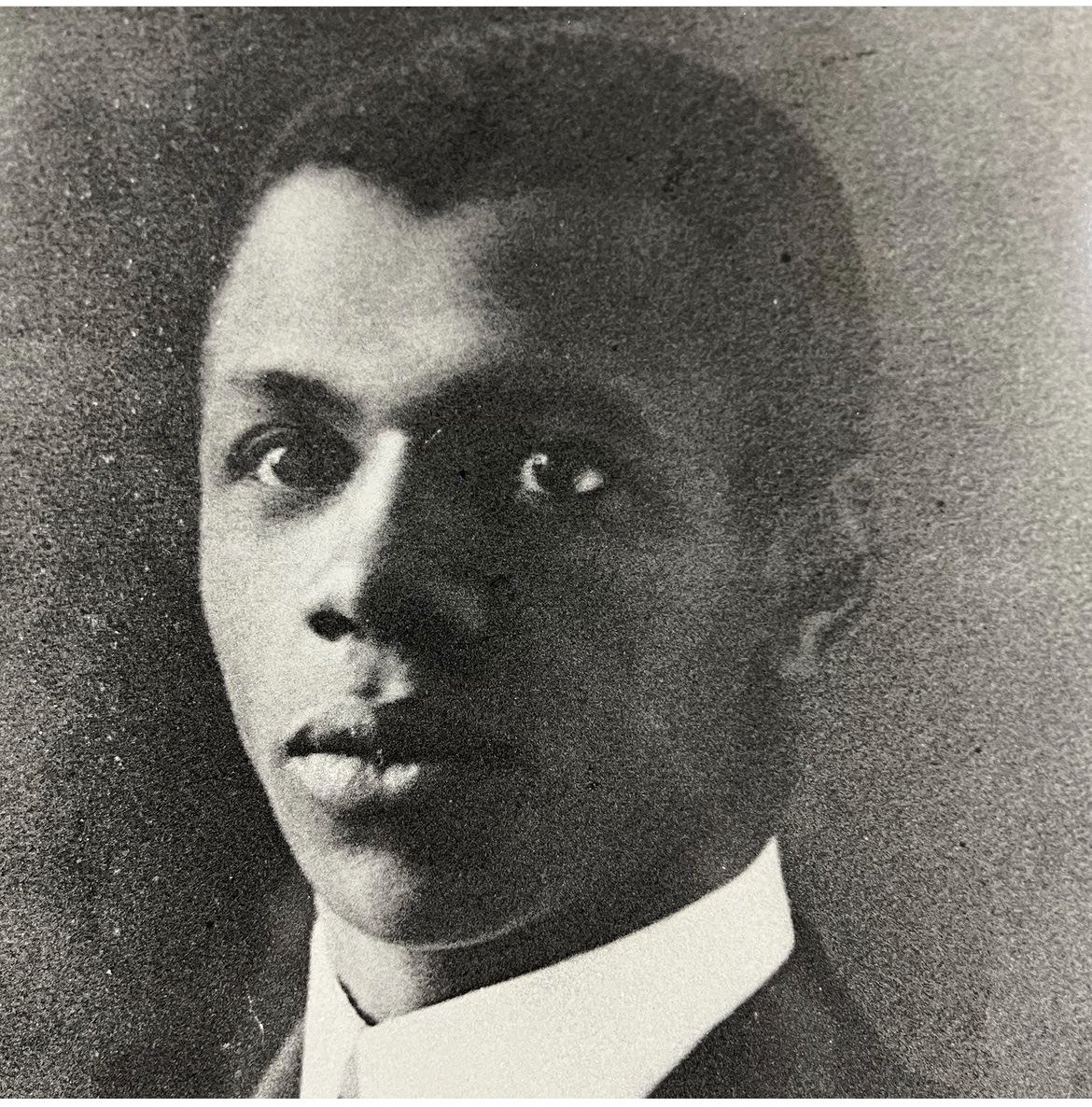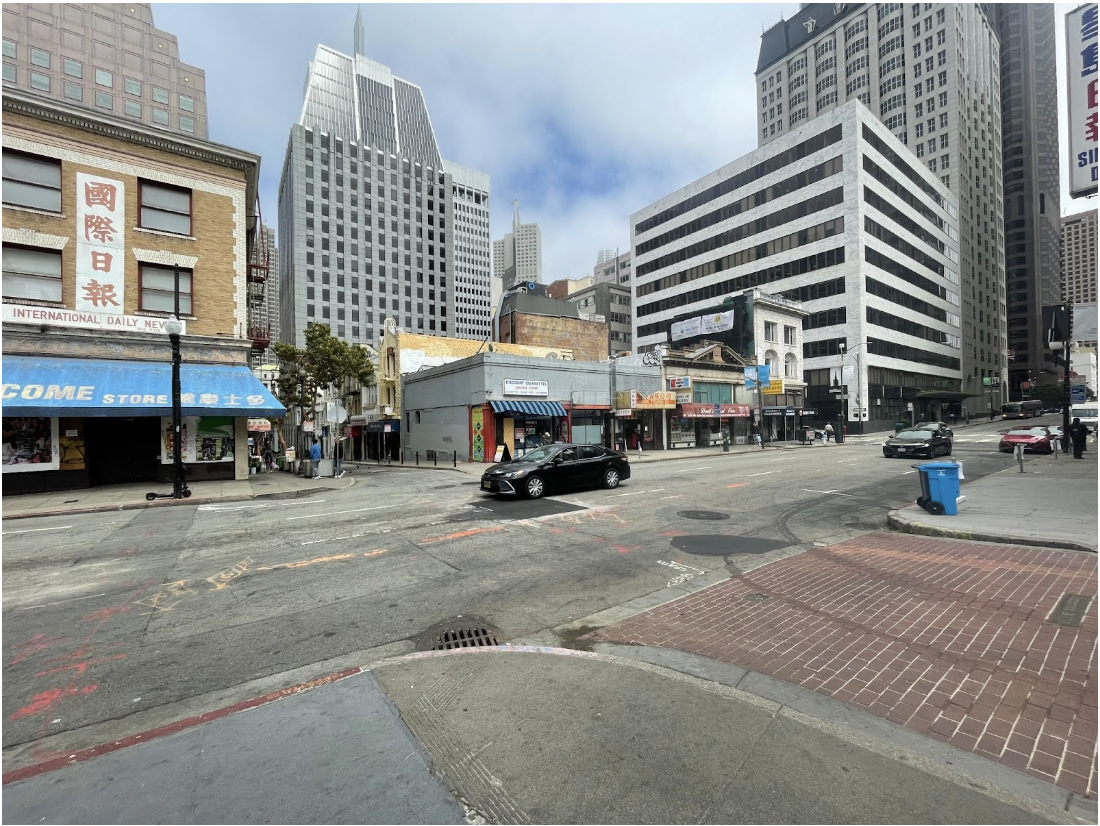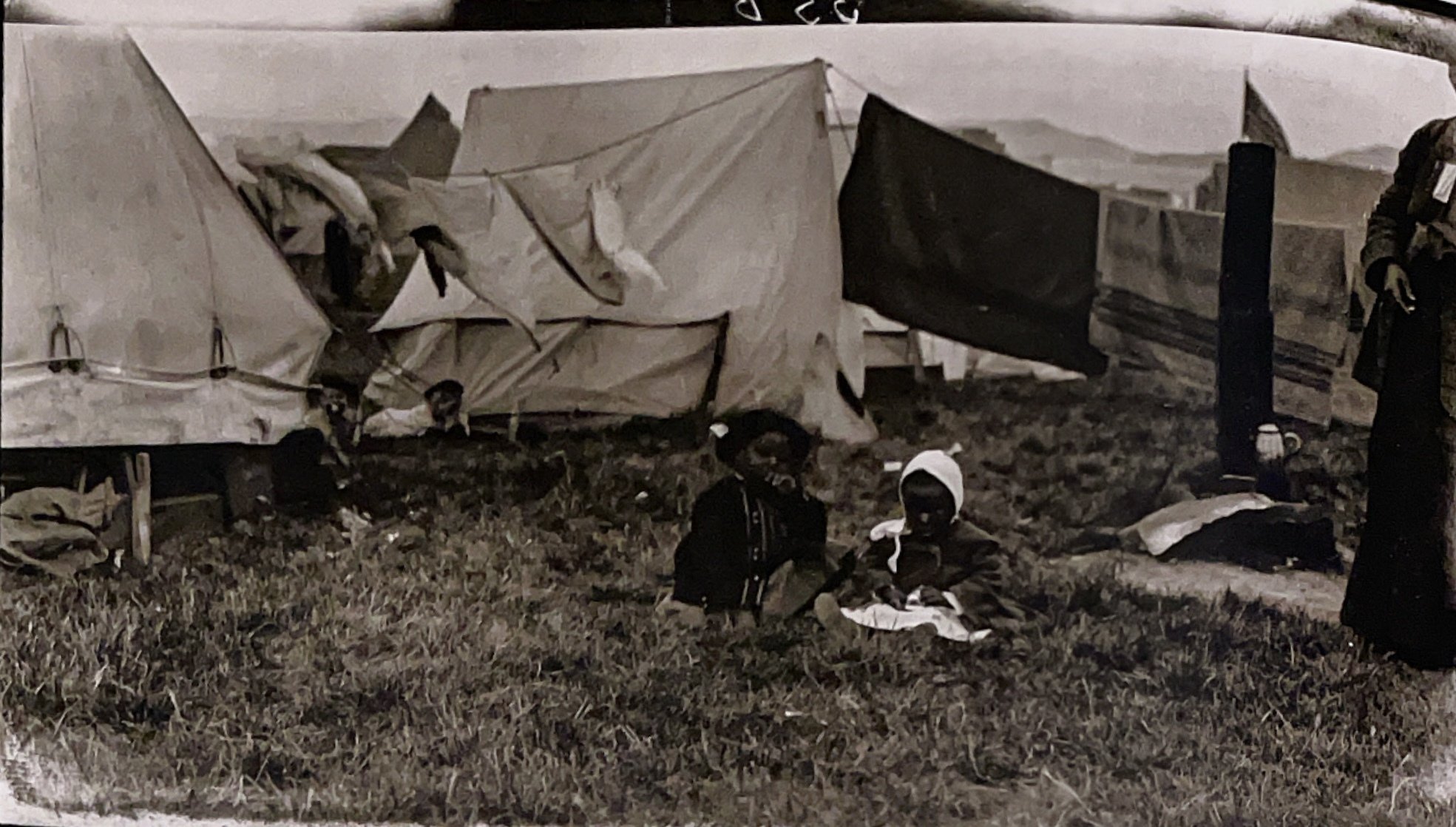we were here
On view at San Francisco Public Library Main Branch, December 21, 2023 - March 1, 2024
Artist Reception
Thursday, January 11, 2024 | 5:00-7:00 pm
African American Center @ the SFPL
100 Larkin Street, 3rd Floor, San Francisco, CA 94102
Free and open to the public
tanea lunsford lynx in Conversation with Albert Broussard Wednesday, February 7 from 6-7 p.m. (via Zoom). Visit sfpl.org to register.
SFPL//SFAC Press Release and Exhibition Notice
Press about the project: How Did Black Residents Grapple With San Francisco’s 1906 Earthquake? A New Exhibit Takes a Look, SF Standard (12/3/23)
Why this SF artist's new library exhibit is 'really special' to her, San Francisco Examiner (12/11/23)
Aurelious Alberga (1884-1988)
we were here is a creative investigation of the Black American presence in San Francisco in the late 1800s and early 1900s, particularly at the occurrence of the 1906 Earthquake. This exhibition grounds into an archival experience and recollection of a larger-than-life story told by Aurelious Alberga (1884-1988) about his experience and survival of San Francisco’s 1906 Earthquake and fires. Interviewed by Albert Broussard in 1976 as part of a larger oral history project organized by the Friends of the Public Library and and the SF African American Historical and Cultural Society.
part 1: Finding aurelious
In the transcripts, ‘Bro’ refers to Albert Broussard, the interviewer. ‘Alb’ refers to Aurelious Alberga.
Where do oral histories live? How do we visit with them if we can’t hold them in our hands? can’t look at them? can’t find them on a shelf and check them out like a book?
I was exploring these questions in the library when I began looking for oral histories. I came upon an oral history project from 1976 co-sponsored by the Friends of the San Francisco Public Library and the San Francisco African-American Historical and Cultural Society that took place with Albert Broussard interviewing Aurelious Alberga.
I began by reading the transcripts, then I paused to listen instead. A voice like my grandfather’s crackled through my headphones. The static buzzing of equipment sounds became background noise as Aurelious Alberga’s stories started to pour out. His stories brought a new imagination of Black people in San Francisco in the 1880’s and early 1900’s into view. I’d known it was true that we were here but I hadn’t seen us, really. I hadn’t seen many photos. And I certainly hadn’t heard us. I hadn’t heard our stories in our own voices.
I listened to the tapes of Aurelious’ stories of life in San Francisco.
I started to look for signs of us here, everywhere.
Commercial and Kearny, 2023. photo by Emily Sullivan
PArt 2: EARTHQUAKE SIMULATION
I remember going to the Academy of Sciences with my grandfather as a child. The earthquake exhibit was one of my favorites to visit. We’d wait our turn in line to go into the dark room with a cohort of other families with children. We would take our space on a platform with a support rail at the front end and a puppet show of sorts would commence. The rows of houses resembling the famous Painted Ladies sat on their hill behind the screen. When the earthquake came, the ground underneath our standing platform shook hard beneath our feet, a jerk then a motion like sifting. The lights flicked on and off in tandem with the sound of delicate things breaking. The hill on the screen before us rolled, the houses shook, some things on the screen snapped in half. Smoke appeared on the screen, then fire rolled up and down the hills of this small, puppet San Francisco.
The earthquake simulator was trying to show us what it felt like to have the magnitude of the 1989 and 1906 earthquakes shaking beneath us. We stood in line again and again for our turn to feel the world shifting from under us.
Part 3: Earthquake as relative
The 1906 Earthquake is regarded as a distant but distinct relative in San Francisco’s family lineage. A big figure who came in and signaled the upheaval and snapping of structures. One who set a fire that couldn’t be tamed for days.
We see the earthquake regarded in literature. We read about the crumbling of buildings, the explosions used to contain the perimeter of the fire. We see grainy sepia photos of the rubble and try to make out the streets. But we don’t hear many voices talking about the earthquake and fires. And we certainly don’t hear Black voices talking about the earthquake and fires.
But we were here.
In part of his recollection of the 1906 earthquake and fires, Alberga situates himself in San Francisco living in a small apartment (likely a single room occupancy (SRO)) in the room one floor beneath his father’s room in the building. At the time he was working for a man from a wealthy family who owned a lot of property throughout San Francisco. The man was blind and Alberga was his driver and caretaker. Alberga talks about yelling out for his father to come help him because the door to his room had caved in during the earthquake and he was trapped from the inside. Upon release from his room, he sets out into the city to go check on his employer, Metzgar, ‘the old man’. Aurelious recalls the corners where buildings crumbled, he recalls the disorientation and awe of seeing familiar locations completely ruined. In the midst of smoke and rubble, Alberga’s recollection (from more than 70 years earlier!) takes a turn for the fantastical, becoming an epoch.
O’Farrell and Stockton, 2023. photo by Emily Sullivan.
Van Ness & Jackson, 2023. photo by Emily Sullivan.
Part 4: Earthquake Cosplay
Every year on April 18th, people wake up early in the morning to meet downtown in San Francisco to retell the harrowing story of the 1906 Earthquake. People dress up in period clothing from 1906--ruffles and petticoats and curling mustaches and top hats. Every so many years a hydrant in the city is painted or repainted gold to commemorate its influence in pumping water to the hoses that helped to finally extinguish the fires all those years ago.
I wonder what Aurelious Alberga was wearing. Even more than that, I wonder what a monument to him might look like. I wonder what it might look like to honor all of the things he lost. I wonder about the loud silences, they are our usual markers of presence in history. But when I read and reread Alberga’s recollection of the earthquake I hear him and know that this story must be resounding, it shifts the ground underneath me.
Part 5: San Francisco as ruin
Gentrification can do this too.
Destroy the familiar
make it absurd,
make it inhabitable and unrecognizable.
Make it a place no longer safe.
A place surrounded by fire.
I’ve seen my familiar places turned to rubble
I’ve seen the smoke rising black
I’ve heard all the sirens
I’ve seen us gather, stuck
Watching the dangermachine wipeout our everything
Telling us this is the only way to save it
Destroy it to save it from destruction
Displacement makes its way through the family
Like a bad stomach bug
A virus that touches us with each
Thin one page letter through the mail slot.
Maybe one day bad news won’t be delivered so coldly.
Maybe one day there won’t be the same bad news.
When everything shifts under your feet
And all made to protect you begins to quiver
With uncertainty
I’ve seen this city in a fit of rage,
Identity forced to change.
Scraping from the foundation
A bad root job.
I’ve seen new metal rising from the ashes and smoke.
One way mirrors
Replacing the clothes drying out of opened windows
Music escaping the intimacy of its own home
The sights and sounds of living
The signs of life
There is no more living here.
Just dragging, just scurrying. Just
Pulling pulling
So the edges of two distant ends of
______________________
Can meet for long enough to cover.
At least there used to be beauty in our struggles.
This earthquake rumbled through
and it was unnatural.
A small tremble--
Leaving the black burnt of our homes hollowed
For blight.
Sold off for pennies.
More shaking out the caving walls
Crumbling and
Dust rising and
Everything coming up the same color--
One we don’t paint with.
Shapes we save for business
Being called a home
But not for us.
There have been thousands of earthquakes.
Thousands of tiny disasters
Causing displacement.
And none of them are natural.
None of them are familiar.
Vallejo & Powell, 2023. photo by Emily Sullivan.
Part 6: if an earthquake could speak
What could it do for the refurbished walls to hear a familiar voice in the time when they survived? What could it do for the streets that didn’t cave to have people walking in a pattern familiar to another time? How good could it be to remember? To recall with certainty? This city needs to hear our stories, recalling when we related to it another way--when we knew each other well. Even if it was in a moment of chaos and destruction.
The silences in our histories are loud. Jumping with the absence of our voices. But not with the absence of us/our presence.
Part 7: we were here
we were here
already living fantastical lives already saving the best for the present already studying the contours of this city.
the Bay knew us. this ocean was salted with our knowing-- already.
we knew the feeling of firm ground before the shaking. we knew stability security.
the ground knew the planting and rising of our feet like a dance
we were already sending for each other, extending a fishing hook South and pulling each other up with calloused hands.
we were already spinning tales about this mass of fog.
we were already making home here.
and when crisis came, it also came for us.
we were already looking for each other in the rubble.
we were already calling each other’s names outside the burning house.
we were already rising from ash here. we were already riding the back of a stubborn crisis.
we were here and like always like now finding a way to laugh at disaster.
because somehow we’d survived it. again.
Even though it followed us even though even though even though
we had losses we knew the black lace of grief over our faces well we knew the heavy weight of nothing to carry because all had been lost
we knew the migration patterns, routes to each other’s homes food cooked with our own hands warmth rubbed into each other’s backs a little space granted for surrender we were already creating an oasis in the storm.
those we lost, we carried with us. regifting their names to the next generation
we may not have monuments
our presence has often been noted
with the signature of loud silence
an extended pitch of quiet
that only we can decipher the notes of
of course we were here living in our signature ways
of course when the earth shifted we went looking for who could be lost in the cracks
of course it made for lore
of course we were doing the fantastical feat like a dance
the earth cracked open and we kept time an offering of our survival, we kept living.
we were here is an interactive creative investigation of the Black American presence in San Francisco in the late 1800s and early 1900s, particularly at the presence of the 1906 earthquake. This exhibit grounds into an archival experience and recollection of a larger than life story told by Aurelious Alberga about the survival of San Francisco’s 1906 Earthquake.
The exhibit highlights available sources at the library including oral history audio clips and printed transcripts along with archival photos of San Francisco in 1906 post-Earthquake. Please find the original oral history here and the accompanying transcript here. Below are photos of San Francisco post 1906 earthquake courtesy of the San Francisco Public Library History Center and photographer Arnold Genthe.
Clay west of Stockton, photo by Arnold Genthe, 1906
two children sit on grass in front of tents in the Presidio in the days following the earthquake and fire, San Francisco. Photo by Arnold Genthe, 1906.
Photo Courtesy of SFPL History Center
Photo Courtesy of SFPL History Center
Photo Courtesy of SFPL History Center
Photo Courtesy of SFPL History Center
Photo Courtesy of SFPL History Center
Photo Courtesy of SFPL History Center




















